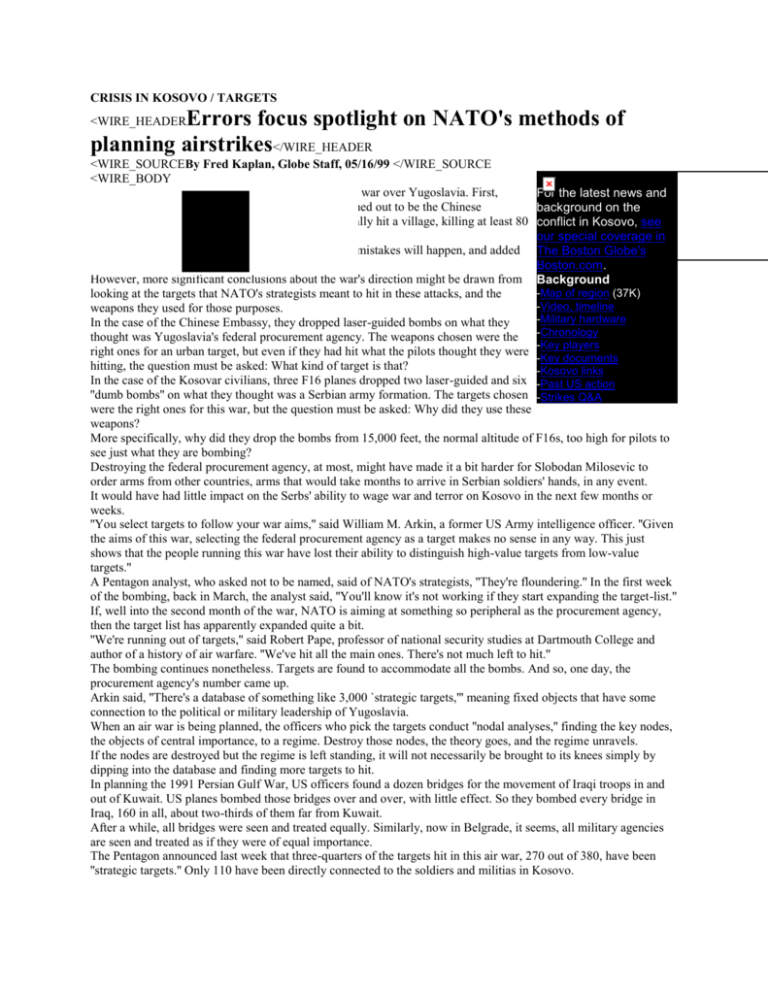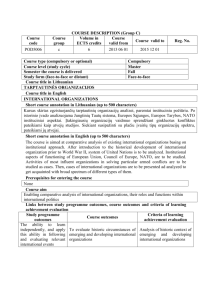boston globe, bridges iraq
advertisement

CRISIS IN KOSOVO / TARGETS Errors focus spotlight on NATO's methods of planning airstrikes</WIRE_HEADER <WIRE_HEADER <WIRE_SOURCEBy Fred Kaplan, Globe Staff, 05/16/99 </WIRE_SOURCE <WIRE_BODY t has been a week of disastrous errors in NATO's air war over Yugoslavia. First, For the latest news and bombs slammed into a building in Belgrade that turned out to be the Chinese background on the Embassy. Then, bombs dropped on Kosovo accidentally hit a village, killing at least 80 conflict in Kosovo, see ethnic Albanian civilians. our special coverage in In each case, NATO officials sent regrets, noted that mistakes will happen, and added The Boston Globe's that the mistakes to date have been remarkably few. Boston.com. However, more significant conclusions about the war's direction might be drawn from Background -Map of region (37K) looking at the targets that NATO's strategists meant to hit in these attacks, and the -Video, timeline weapons they used for those purposes. -Military hardware In the case of the Chinese Embassy, they dropped laser-guided bombs on what they thought was Yugoslavia's federal procurement agency. The weapons chosen were the -Chronology -Key players right ones for an urban target, but even if they had hit what the pilots thought they were -Key documents hitting, the question must be asked: What kind of target is that? -Kosovo links In the case of the Kosovar civilians, three F16 planes dropped two laser-guided and six -Past US action ''dumb bombs'' on what they thought was a Serbian army formation. The targets chosen -Strikes Q&A were the right ones for this war, but the question must be asked: Why did they use these weapons? More specifically, why did they drop the bombs from 15,000 feet, the normal altitude of F16s, too high for pilots to see just what they are bombing? Destroying the federal procurement agency, at most, might have made it a bit harder for Slobodan Milosevic to order arms from other countries, arms that would take months to arrive in Serbian soldiers' hands, in any event. It would have had little impact on the Serbs' ability to wage war and terror on Kosovo in the next few months or weeks. ''You select targets to follow your war aims,'' said William M. Arkin, a former US Army intelligence officer. ''Given the aims of this war, selecting the federal procurement agency as a target makes no sense in any way. This just shows that the people running this war have lost their ability to distinguish high-value targets from low-value targets.'' A Pentagon analyst, who asked not to be named, said of NATO's strategists, ''They're floundering.'' In the first week of the bombing, back in March, the analyst said, ''You'll know it's not working if they start expanding the target-list.'' If, well into the second month of the war, NATO is aiming at something so peripheral as the procurement agency, then the target list has apparently expanded quite a bit. ''We're running out of targets,'' said Robert Pape, professor of national security studies at Dartmouth College and author of a history of air warfare. ''We've hit all the main ones. There's not much left to hit.'' The bombing continues nonetheless. Targets are found to accommodate all the bombs. And so, one day, the procurement agency's number came up. Arkin said, ''There's a database of something like 3,000 `strategic targets,''' meaning fixed objects that have some connection to the political or military leadership of Yugoslavia. When an air war is being planned, the officers who pick the targets conduct ''nodal analyses,'' finding the key nodes, the objects of central importance, to a regime. Destroy those nodes, the theory goes, and the regime unravels. If the nodes are destroyed but the regime is left standing, it will not necessarily be brought to its knees simply by dipping into the database and finding more targets to hit. In planning the 1991 Persian Gulf War, US officers found a dozen bridges for the movement of Iraqi troops in and out of Kuwait. US planes bombed those bridges over and over, with little effect. So they bombed every bridge in Iraq, 160 in all, about two-thirds of them far from Kuwait. After a while, all bridges were seen and treated equally. Similarly, now in Belgrade, it seems, all military agencies are seen and treated as if they were of equal importance. The Pentagon announced last week that three-quarters of the targets hit in this air war, 270 out of 380, have been ''strategic targets.'' Only 110 have been directly connected to the soldiers and militias in Kosovo. The bombs dropped on what NATO pilots thought were Serbian army sites may reflect a shift of emphasis in the war. But the results show the peril of dropping unguided bombs on areas where civilians are wandering as well, especially from high altitudes. ''F-16 pilots, flying 400 to 500 miles per hour, 15,000 feet up, really can't tell the difference between civilian and military vehicles,'' Pape said. In the Gulf War, most of the damage to the Iraqi Army was done by A-10s, which can fly lower and slower because they are built of tougher material and are harder to shoot down. F-16s did much damage in the Gulf as well, but only after US and allied planes had decimated enemy antiaircraft weapons, which, apparently, has not yet happened in this war. </WIRE_BODY This story ran on page A25 of the Boston Globe on 05/16/99. © Copyright 1999 Globe Newspaper Company.











